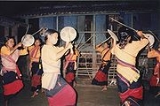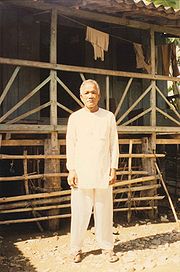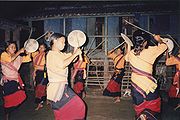
Rabha
Encyclopedia

West Bengal
West Bengal is a state in the eastern region of India and is the nation's fourth-most populous. It is also the seventh-most populous sub-national entity in the world, with over 91 million inhabitants. A major agricultural producer, West Bengal is the sixth-largest contributor to India's GDP...
and Assam
Assam
Assam , also, rarely, Assam Valley and formerly the Assam Province , is a northeastern state of India and is one of the most culturally and geographically distinct regions of the country...
. The language/dialect spoken by the Rabha people is also of the same name. In West Bengal
West Bengal
West Bengal is a state in the eastern region of India and is the nation's fourth-most populous. It is also the seventh-most populous sub-national entity in the world, with over 91 million inhabitants. A major agricultural producer, West Bengal is the sixth-largest contributor to India's GDP...
, Rabha people mainly live in Jalpaiguri district
Jalpaiguri District
Jalpaiguri district is the largest district of North Bengal, covering an area 6,245 km2. It is situated between 26° 16' and 27° 0' North latitudes and 88° 4' and 89° 53' East longitudes...
and Cooch Behar district
Cooch Behar District
Cooch Behar district is a district of the state of West Bengal, India, as well as the district's namesake town. During the British Raj, the town of Cooch Behar was the seat of a princely state of Koch Bihar, ruled by the Koch dynasty....
. Moreover, almost, 70 per cent of them live in Jalpaiguri district
Jalpaiguri District
Jalpaiguri district is the largest district of North Bengal, covering an area 6,245 km2. It is situated between 26° 16' and 27° 0' North latitudes and 88° 4' and 89° 53' East longitudes...
. In Assam
Assam
Assam , also, rarely, Assam Valley and formerly the Assam Province , is a northeastern state of India and is one of the most culturally and geographically distinct regions of the country...
, the Rabhas live mostly in Goalpara
Goalpara
Goalpara is the district headquarter of Goalpara district, Assam, India. It is situated west of Guwahati.-Etymology:The name of Goalpara is said to have originally derived from `Gwaltippika` meaning `Guwali village` or the village of the milk men. In the local dialect "para" means...
and Kamrup
Kamrup
Kamrup district is an administrative district in the state of Assam in India, named after Kamarupa, a name by which Assam was previously known in ancient times. The district, however, is now a small western part of Assam, with a distinctive native Kamrupi culture and dialect . The distinctive...
districts. The whole area of Eastern and Western Dooars, may be termed as the cradle land of the Rabhas.
Ethnicity and Language
The Rabhas belong to the Indo-Mongoloid group of people and have similarities with other members of BodoBodo people
The Bodos are an ethnic and linguistic community, early settlers of Assam in the North-East of India. According to the 1991 census, there were 1.2 million Bodos in Assam which makes for 5.3% of the total population in the state. Bodos belong to a larger ethnic group called the Bodo-Kachari. The...
group such as Garos
Garo (tribe)
See also Garo for other uses.The Garos are a tribal people in Meghalaya, India and neighboring areas of Bangladesh, who call themselves A·chik Mande or simply A·chik or Mande...
, Kachari
Bodo-Kachari
Bodo-Kachari is a generic term applied to a number of ethnic groups predominantly in Assam speaking Tibeto-Burman languages or claiming a common ancestry.-Origins:...
, Mech
Mech tribe
Mech tribe is one of the scheduled tribes of India and belong to Bodo-Kachari group of tribes. They belong to Mongoloid race and speak mainly Bodo language, which is a Tibeto-Burman dialect but have got influenced by the Assamese language. The Mech people live in the Dooars region of West Bengal...
, Koch
Koch
Koch may refer to:* Koch , a type of Arctic boat* Koch people , an ethnic group originally from the ancient Koch kingdom in north east India* Koch , people with this surname* Koch, Łódź Voivodeship, a village in central Poland...
, Hajong
Hajong
The Hajong is a tribal ethnic group in the Indian Subcontinent & four major Tribe in Meghalaya. Hajong people are spread out across northeast India and Bangladesh. At present their population is more than 100,000 in India and 30,000 in Bangladesh. Hajongs are predominantly rice farmers although...
and others. Most of the Rabhas of Dooars refer to themselves as Rabha, but some of them often declare themselves as Kocha. According to Dr. Francis Buchanan-Hamilton
Francis Buchanan-Hamilton
Dr Francis Buchanan, later known as Francis Hamilton but often referred to as Francis Buchanan-Hamilton was a Scottish physician who made significant contributions as a geographer, zoologist, and botanist while living in India.The standard botanical author abbreviation Buch.-Ham. is applied to...
, the aspects of socio-religious and material life of the Rabhas have similarities with those of the Pani-Koch. E. Dalton on the other hand, argues that the Rabhas and the Hajongs are the branches of Kachari
Kachari
Kachari or Cachari may refer to:*Kachari people*Kachari Kingdom*Kachari language*The Kachari Ruins in Dimapur...
race and connected with the Garo
Garo (tribe)
See also Garo for other uses.The Garos are a tribal people in Meghalaya, India and neighboring areas of Bangladesh, who call themselves A·chik Mande or simply A·chik or Mande...
. According to B.H. Hodgson the Rabhas belong to the Great Bodo
Bodo people
The Bodos are an ethnic and linguistic community, early settlers of Assam in the North-East of India. According to the 1991 census, there were 1.2 million Bodos in Assam which makes for 5.3% of the total population in the state. Bodos belong to a larger ethnic group called the Bodo-Kachari. The...
or Mech ft Pani-Koch and the Rabhas have the same lineage and the latter has their connection with the Garo
Garo (tribe)
See also Garo for other uses.The Garos are a tribal people in Meghalaya, India and neighboring areas of Bangladesh, who call themselves A·chik Mande or simply A·chik or Mande...
. A. Playfair (1909) also has pointed out some linguistic and cultural similarities between the Rabhas and the Garos. He also remarks that there exists a striking linguistic affinity between the A'Tong language
A'Tong language
A'Tong is a language of the Sino-Tibetan family, related to Koch and Rabha. It is spoken in the Southern Meghalaya region of India....
and the Rangdania (Rabha) dialects. This led him to think that, at some point of time they lived in contact with each other.
The Rabhas of West Bengal and Assam generally speak the local Bengali and Assamese dialects. The Rabhas who live in the forest villages have retained their original Rabha dialect to a great extent. The Rabha dialect, as stated by George Abraham Grierson
George Abraham Grierson
Sir George Abraham Grierson OM KCIE was born to a prominent Dublin family in 1851. His father and grandfather, both also named George, were well-known printers and publishers.-Biography:Educated at St...
, belongs to Bodo
Bodo language
Bodo is a language that belongs to the branch of Barish section under Baric division of the Tibeto-Burman languages and spoken by the Bodo people of north-eastern India and Nepal...
group of languages of Assam-Burmese branch.
Economy and Society
The traditional economyTraditional economy
Traditional economy is a catching-all term normally used to describe economic systems that pertain in societies with extensive subsistence agriculture. The term may also be used for any economy that falls outside of popular notions of market and command economies...
of the Rabhas in general, is based on agriculture
Agriculture
Agriculture is the cultivation of animals, plants, fungi and other life forms for food, fiber, and other products used to sustain life. Agriculture was the key implement in the rise of sedentary human civilization, whereby farming of domesticated species created food surpluses that nurtured the...
, forest based activities and weaving. In the past, the Rabhas used to practice shifting cultivation. They continued to cultivate the land with Gogo or bill-hook. Later they took up the job of settled cultivation and started cultivation with plough
Plough
The plough or plow is a tool used in farming for initial cultivation of soil in preparation for sowing seed or planting. It has been a basic instrument for most of recorded history, and represents one of the major advances in agriculture...
. Besides cultivation, hunting was also an old practice of Rabha people. Weaving was a traditional occupation of the Rabha women.
Rabhas, who once used to live in the forest and practice shifting cultivation
Shifting cultivation
Shifting cultivation is an agricultural system in which plots of land are cultivated temporarily, then abandoned. This system often involves clearing of a piece of land followed by several years of wood harvesting or farming, until the soil loses fertility...
, were deprived of their rights to the forest by the colonial rulers, since the formation of forest department, banning on shifting cultivation and demarcation of forest boundaries. Consequently, with the colonial land settlement system, most of the displaced Rabhas either adopted settled cultivation as sharecroppers or took refuge in the forest villages as plantation laboueres. After independence, Indian Government more or less continued the same colonial system of forest management
Forest management
200px|thumb|right|[[Sustainable development|Sustainable]] forest management carried out by [[Complejo Forestal y Maderero Panguipulli|Complejo Panguipulli]] has contributed to the preservation of the forested landscape around [[Neltume]], a sawmill town in Chile...
, where the communities like Rabhas could not regain their rights to the forest.
Today, one finds Rabhas in diverse occupations from forest workers and cultivators to all modern occupations like school teachers and government office bearers etc., though their number in white-collar jobs would not be very high.
Religion and culture

Animism
Animism refers to the belief that non-human entities are spiritual beings, or at least embody some kind of life-principle....
rituals. However, today they more often follow a faith, which is a blend of some Hindu
Hinduism
Hinduism is the predominant and indigenous religious tradition of the Indian Subcontinent. Hinduism is known to its followers as , amongst many other expressions...
and a few animistic rituals. There are considerable differences in ritual practices among forest Rabhas who still live in the forest villages and the Rabhas that live in the villages as cultivators. The forest Rabhas follow traditional animistic practices tinged with some rituals of mainstream Hinduism. On the other hand village Rabhas have merged with local Hindus as far as their religious practices are concerned.
Rabha people's religious world is pervaded with various spirits and natural objects. The main deity of the Rabhas is called Rishi. Rishi, for the forest Rabhas as well as village Rabhas, is a male deity. He is also known as Mahakal. Forest Rabhas worship him in all important social and religious ceremonies.
In addition, there are the deities Rungtuk and Basek, represented by two earthen pots of rice placed on the northern side of the store. These two deities are considered as the daughters of Rishi or Mahakal. Rungtuk and Basek are household deities and considered as the deities of wealth like the Hindu Goddess Lakshmi
Lakshmi
Lakshmi or Lakumi is the Hindu goddess of wealth, prosperity , light, wisdom, fortune, fertility, generosity and courage; and the embodiment of beauty, grace and charm. Representations of Lakshmi are also found in Jain monuments...
. The Rungtuk and basek, are inherited by the heiress of the family. Their traditional priest deosi, counts the auspicious day for the foundation of these deities. The room where they are kept is occupied by the head of the family. The deities do not have any idols. A red coloured earthen pitcher filled with rice represents the deity Rungtuk. An egg is kept on the neck of the pitcher.
Like in most tribal communities, dances and music play an important part in the lives of the Rabhas. After every ritual they perform various dances to ingratiate their deities. Most of the Rabha women can both sing and dance.
Like most tribal dances, those of the Rabhas are connected to some daily agrarian activity. They have a unique dance form named "Nakchung Reni" to celebrate fishing in the forest rivulets. Rabha women of all ages take part in this dance whole-heartedly.
See also
- Bishnuprasad RabhaBishnuprasad RabhaBishnu Prasad Rabha was born in Dhaka on 31 January 1909. He was a multifaceted artist and revolutionary singer of Assam. A doyen of the Arts, he is popularly known as Kala Guru . From an early stage, he played an active role in the struggle for Indian independence. However, he never joined Indian...
- Assamese languageAssamese languageAssamese is the easternmost Indo-Aryan language. It is used mainly in the state of Assam in North-East India. It is also the official language of Assam. It is also spoken in parts of Arunachal Pradesh and other northeast Indian states. Nagamese, an Assamese-based Creole language is widely used in...
- Himalayan Languages ProjectHimalayan Languages ProjectThe Himalayan Languages Project, launched in 1993, is a research collective based at Leiden University and comprising much of the world's authoritative research on the lesser-known and endangered languages of the Himalayas, in Nepal, China, Bhutan, and India. Its members regularly spend months or...

